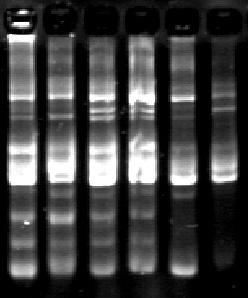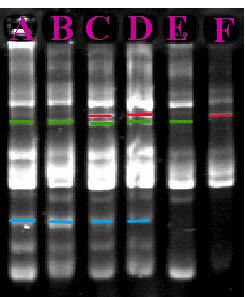
Agarose Gel

Polymorphic bands colorized
Individual A - site 2 (green dot on map)
Individual B - site 2
Individual C - site 3 (red dot on map)
Individual D - site 3
Individual E - site 3
Individual F - site 4 (purple dot on map)
A
B
C
D
E
F
Analysis of Similarity
Individuals A-F were scored as to whether they contained the bands A (red), B (green) or C (blue), bands that showed polymorphism. A comparison was made between individuals A compared to B, A compared to C, etc to achieve a % similarity (see % similarity matrix at left). The table at right shows the similarity achieved with three markers. For example, individuals A and B were identical to each other and individuals C and D were identical to each other. Individuals A and B were both from site 2. Individuals C and D (both from site 3) were only 33% similar with individual E, which was also from site 3.
A
1.0
1.0
.66
.66
.66
0
B
1.0
.66
.66
.66
0
C
1.0
1.0
.33
.33
D
1.0
.33
.33
E
1.0
.33
F
1.0